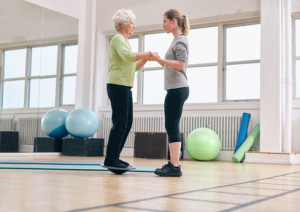Your muscles get bigger and stronger when you use them. Your bones are similar! They get stronger and denser when you make them work. And “work” for bones means handling impact, the weight of your body or more resistance. Currently, we know the most about two types of exercises that are important for building and maintaining bone density. These exercises are:
1. Weight-bearing exercises. These exercises include activities that make you move against gravity while being upright. They include both high-impact and low-impact activities. Examples of high-impact weight-bearing activities are jogging and dancing. See Group 1 in the chart on the right for more examples.
If you can’t do high-impact weight-bearing activities, try one of the lower-impact ones listed in Group 2. Biking and swimming are not weight-bearing exercises, so they don’t help your bones as much. If you bike or swim, make sure to also include activities in your weekly exercise routine that work your bones.
|
Which Exercises Are Best? The exercises listed in Group 1 are the best for keeping bones strong. If you have osteoporosis, fall easily or are frail, choose safer options from Groups 2 or 3. |
|
| Group 1: High-Impact Weight-Bearing Exercises | |
| Aerobic Dancing | Jumping Rope |
| Basketball | Lacrosse |
| Dancing | Racquet Sports |
| Field Hockey | Soccer |
| Gymnastics | Stair Climbing |
| Hiking | Tennis |
| Jogging or Running | Volleyball |
| Group 2: Low-Impact Weight-Bearing Exercises | |
| Cross-Country Ski Machines* | Low Impact Aerobics |
| Downhill & Cross-Country Skiing* | Stair-Step Machines |
| Elliptical Training Machines | Walking briskly |
| Group 3: Muscle-Strengthening Exercises | |
| Exercise Bands | Weight Machines |
| Pilates** | Yoga** |
| Weight Lifting/Resistance Training | |
| *Avoid if you have balance problems or are at risk of falls. **Avoid forward-bending exercises. |
|
If you haven’t been exercising regularly, check with your healthcare provider before starting a new program—particularly if you have health problems such as heart disease, diabetes or high blood pressure. Once you have your healthcare provider’s approval, start slowly.
2. Muscle-strengthening exercises. These exercises include activities where you move your body, a weight or some other resistance against gravity. These exercises are also known as resistance exercises.
Muscle-strengthening exercises include lifting weights, using elastic exercise bands, using weight machines or lifting your own body weight. Yoga and Pilates are also muscle-strengthening exercises. However, people with osteoporosis and low bone density need to avoid certain positions. For example, if you’ve already had broken bones in the spine due to osteoporosis, be very careful to avoid activities that require reaching far, bending forward, rapid twisting motions, heavy lifting and any movements that increase your chance of a fall.
How Much Exercise Should I Do?
Weight-bearing, impact exercises should be done for a total of 30 minutes per day, five to seven days per week. You can do 30 minutes at one time or break it up during the day. For example, 3 sessions of 10 minutes each will provide a similar bone benefit as one 30-minute session. If you can’t fit 10 minutes in, spread your exercise throughout the day by taking the stairs or by parking farther from the store or work.
Muscle-strengthening exercises should be done two to three days a week. You should aim for one exercise for each major muscle group for a total of 8-12 exercises. You should do one or two sets of 8 to 10 repetitions for each exercise. If you lift a weight 10 times in a row and stop, you have completed one set of 10 repetitions. If you can’t do 8 in a row, the weight is too heavy or resistance is too much. If you can do more than 10 in a row, you should probably increase the weight or resistance. If you have osteoporosis or are frail, it may be better to do 10 to 15 repetitions with a lighter weight.
If you don’t have much time for muscle-strengthening, do small amounts at a time. You can do just one body part each day. For example work arms one day, legs the next and trunk the next. You can also spread these exercises out during your normal day. As you get started, your muscles may feel sore for a day or two after you exercise. If the soreness lasts longer, you may be working too hard and need to ease up. Exercises should be done in a pain-free range of motion. If you’ve broken a bone or have osteoporosis, consider working with a physical therapist (PT) to learn how to exercise safely.
Balance, Posture and Functional Exercises
 1. Balance Exercises. Exercises that strengthen your legs and challenge your balance can decrease your risk of falls.
1. Balance Exercises. Exercises that strengthen your legs and challenge your balance can decrease your risk of falls.
2. Posture Exercises. Exercises that improve your posture and reduce rounded or “sloping” shoulders can help you decrease your chance of breaking bones in the spine.
3. Functional Exercises. Exercises that improve how well you move can help you in everyday activities and decrease your risk of falls and broken bones. For example, if you have trouble getting up from a chair or climbing stairs, you should do functional exercises.
A physical therapist can teach you balance, posture and functional exercises. A referral from your primary care provider is generally needed.
Other Recommendations. A regular exercise program reduces the chance of falling by improving balance, coordination and muscle strength. Exercise has greater benefits for bone health when it is combined with a healthy diet with enough calcium and vitamin D. Some people also need to take an osteoporosis medicine to reduce the chance of breaking a bone.
Susan Randall RN, MSN, FNP-BC is Senior Director of Education for the National Osteoporosis Foundation (NOF) in Washington, DC,

